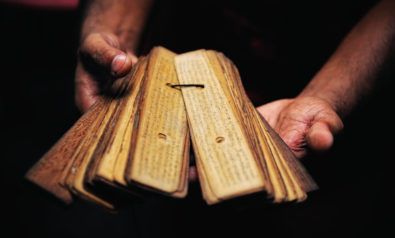During the English Revolution, authorities could no longer burn people, but they could still burn their books.
What historians chose to write about is often informed not just by their intellectual interests, but also by present-day concerns. Sometimes those connections are drawn subtly. But on occasion they are blatant. Whether it’s the link between the study of women in the past and the modern struggle for sexual equality, interest in advances in medical knowledge prompted by fear of deadly epidemic disease, or sensitivity to changing attitudes to the natural world motivated by justifiable alarm of impending environmental catastrophe, the present is in constant dialogue with the past. Historical discussion of book burning is no different.
It’s no coincidence that ground-breaking works dealing with the subject were published during the early 1930s – just as the Nazis were burning books in Germany. Here, at a moment when Internet censorship is being imposed by certain governments, when even a British journalist feels compelled to provocatively say that you can’t read his book, it seems appropriate to talk briefly about my own area of expertise. That is, book burnings in revolutionary England from 1641 to 1660.
Exercising censorship through book burning – even if not always successful – was an aspect of European ecclesiastical and civil policy for several centuries. It’s a common misconception, however, to think of public book burnings only in terms of censorship. That’s because when performed before large crowds they were simultaneously spectacles with a message. And, despite changing contexts and different audiences, that message remained essentially unchanged: authority’s displeasure with texts that were considered to represent serious challenges to its dominance. In other words, public book burnings were as much about legitimating power through dramatic rituals as maintaining it by suppressing dissenting ideas and scandalous statements.
Contexts
Before discussing English book burnings some context is necessary. This was a turbulent period, one that has always fascinated historians because so many important things happened and so many significant ideas saw the light of day. In the words of England’s first communist leader, the Digger Gerrard Winstanley, the “old World” had been turned upside down and was “running up like parchment in the fire.”
There was devastating Civil War and rebellion in the three kingdoms of England, Scotland and Ireland. Episcopacy was abolished. The Church of England lost its power and the clergy became increasingly hated. There were petitioning campaigns to introduce religious toleration and initiate much needed ecclesiastical, educational, electoral, legal, medical and taxation reforms. Political movements with radical demands such as the Levellers emerged. King Charles I was executed.
Many people feared a coming apocalypse. Prophets and visionaries arose preaching repentance, warning sinners that the world’s end was imminent. New religious movements like the Quakers began evangelizing campaigns. And, gradually, the British Republic mutated from an oligarchy into a de facto dictatorship. Oliver Cromwell ruled as an uncrowned Lord Protector supported by an unsteady alliance of magistracy, ministry and military might. In the background were widespread poverty, harvest failure, desperate food shortages, economic decay and outbreaks of plague.
An Explosion of Print
Between 1641 and 1660, an estimated 32,238 titles were published in the British Isles or by English speakers elsewhere in the world. That is roughly 26% of the total amount of such publications between 1475 and 1700.
Despite one well-known historian’s claim that the English Revolution was a short-lived age of “freedom,” when relatively cheap and portable printing equipment may have made it easier than ever before for new and sometimes radical ideas to see the light of day, the desire to censor – as is widely recognized – remained in many quarters. There were three effective ways in which this could be achieved: through pre-publication, post-publication and self-censorship.
Pre-publication censorship, particularly of religious literature, which had been used to increasing effect during the 1630s, became a lost cause after 1641. For in that year the secular court of Star Chamber and the ecclesiastical court of High Commission were abolished by act of Parliament. Consequently, the monopoly hitherto enjoyed by the London Stationers’ Company disintegrated.
Burning books was an effective way of destroying particular printed texts. But not, it must be emphasized, of eradicating them. For it appears that at least one example survives of every book, pamphlet, broadsheet and newspaper ordered to be burned in England between 1640 and 1660.
With the collapse of pre-publication censorship the licensing system upon which it had been built became increasingly used to protect the publisher’s copyright rather than to indicate official approval. Despite initial Parliamentary attempts at reasserting control by examining those considered responsible for committing abuses in printing and licensing, and subsequently through legislation, without an equivalent to the Papal Index of prohibited books pre-publication censorship appears to have been almost entirely at the licenser’s discretion. As such it was utterly ineffective. Indeed, during the later 1640s and much of the 1650s licensing was characterized by inconsistent practice and the absence of a universally agreed strategy.
By contrast, post-publication censorship and a range of severe punishments remained. Doubtless, legislation empowering civil and military officials to fine or imprison the authors, printers, publishers and booksellers of unlicensed material prompted strategies to avoid detection. The most common were spurious imprints, anonymity and pseudonymity.
Thus several works omitted the names and addresses of those involved in their production. Sometimes proprietary details were replaced with defiant political messages or apocalyptic warnings: “to be sold at his Shop in Toleration Street, at the Signe of the Subjects Liberty, right opposite to Persecuting Court”; “printed … in the sitting of Parliament; during which time the Presse ought to be free and open”; “at London, in the beginning of that notable day, wherein the secrets of all hearts are laid open; and wherein the worst and foulest of villanies, are discovered.” Alternatively, it was falsely claimed that certain texts had been issued abroad – at Amsterdam and Rotterdam for example. Some authors also exercised varying degrees of self-censorship.
All the same, post-publication censorship proved most effective when implemented by those with intimate knowledge of the printing trade. And in exceptional circumstances its outcome could be dramatic.
Purification by Fire
Excluding corrupt translations of the Bible imported from the Netherlands, Catholic primers, missals and a liturgical devotion to the Virgin Mary, 60 identified printed books, pamphlets and broadsheets, and three newspapers were ordered to be burned by civil, military and ecclesiastical authorities in England between 1640 and 1660. In addition, Parliament ordered a number of letters, particularly those maligning its military commanders, to be burned.
The largest group of books burned during this period was incendiary political pamphlets by the Leveller leaders and their supporters. Defamed as atheists, mutineers, rebels and villains, this increasingly well-organized political movement agitated for a host of reforms including religious toleration; equality before the law; accountability of elected officials; regular Parliaments; the abolition of rotten boroughs; and an extension of the electoral franchise to incorporate more – but by no means all – adult males.
Another important cluster of writings consigned to the flames was those that promoted religious heresies. That considered most dangerous of all was denial of the Trinity since the entire foundation of Nicene Christianity depended upon it. Indeed, such was the fear of anti-Trinitarian heresies that writers publicly proclaiming the Trinity to be an outmoded superstition were denounced from across almost the entire theological spectrum.
A second type of dangerous book concerned profanation of the Sunday Sabbath. Equally appalling for contemporaries was the teaching that God was responsible for human sin. But more shocking still were those accused of believing themselves incapable of committing sin. They were called Ranters. And scandalized contemporaries generally demonized them as a promiscuous, ungodly crew given to all manner of wickedness. Among their alleged irreverent and debauched activities were blaspheming, cursing, swearing, drunkenness, tobacco smoking, mixed dancing, whoring, and even public nakedness.
Clearly, texts that were burned publicly had transgressed accepted limits, whether of political and religious discourse, or of public conduct. They either challenged the establishment by being too radical. Or they went beyond the boundaries of what could be tolerated in thought and behavior.
Protestant Autos da Fé
Borrowing from continental practice, the use of the hangman in public book burnings had been introduced to England in May 1634. By 1640, his presence had become a familiar aspect of a scene of street theatre designed to frighten onlookers. The locations selected for these ritual mock executions by fire were invariably large open public spaces in the Cities of London and Westminster and the Universities of Oxford and Cambridge; Cheapside, Smithfield, Paul’s churchyard and the Old Exchange in London, the New Palace at Westminster and the Market Place in Southwark.
No one had been burned at the stake for heresy in England since 1612 – not even witches, who were hung by the neck. But in a country which still torched the Pope and other prominent Catholics in effigy, the published writings of seditionists and blasphemers were continually consigned to the flames in public book burning rituals that resembled Protestant Autos da Fé by proxy.
Burning books was an effective way of destroying particular printed texts. But not, it must be emphasized, of eradicating them. For it appears that at least one example survives of every book, pamphlet, broadsheet and newspaper ordered to be burned in England between 1640 and 1660. Indeed, there is evidence that book burning occasionally stimulated demand for condemned works by arousing the curiosity of collectors. As Daniel Defoe was to remark, he once heard a bookseller say that “if he would have a book sell, he would have it burnt by the hands of the common hangman.”
Holocausts
holocaust, noun: 1. a sacrifice wholly consumed by fire; a whole burnt offering [Oxford English Dictionary]
Public book burning was the most dramatic method of post-publication censorship in early modern England. As an aspect of legislation designed to regulate the press it worked in concert with Parliamentary efforts to suppress religious dissent. Together these measures created a climate in certain circles conducive to self-censorship.
There are numerous instances of authors not putting their names to inflammatory printed works. Printers, publishers and booksellers were even more cautious. Even when risks were taken by committed individuals printing remained a fairly expensive business. It did not become more affordable in the 1640s and 1650s. For despite an explosion of print it seems that besides the rich generally only those with wealthy benefactors or organized collective support had sufficient means to publish their writings. Moreover, the 1630s had seen a sudden and sharp rise in book prices and, if the complaints of stationers are to be believed, prices remained high in the succeeding two decades. If this was an age of freedom, it was a relatively limited one.
On January 26, 1661 the bodies of Oliver Cromwell and his son-in-law Henry Ireton were disinterred from their graves in Westminster Abbey. A few days later, on the anniversary of the execution of Charles I, their bodies together with that of the king’s judge John Bradshaw were hung at Tyburn. In May 1661, Charles II’s regime continued with its attempt to erase the English Commonwealth and Protectorate from historical memory by ordering key republican legislation to be burned.
The nineteenth-century German poet Heinrich Heine famously had a character remark in his tragedy Almansor that “where they have burned books, they will end in burning human beings.” During the English Revolution and long after the restoration of the monarchy, however, the contrary was the case: where they could no longer burn people they could still burn their books.
The views expressed in this article are the author’s own and do not necessarily reflect Fair Observer’s editorial policy.
Support Fair Observer
We rely on your support for our independence, diversity and quality.
For more than 10 years, Fair Observer has been free, fair and independent. No billionaire owns us, no advertisers control us. We are a reader-supported nonprofit. Unlike many other publications, we keep our content free for readers regardless of where they live or whether they can afford to pay. We have no paywalls and no ads.
In the post-truth era of fake news, echo chambers and filter bubbles, we publish a plurality of perspectives from around the world. Anyone can publish with us, but everyone goes through a rigorous editorial process. So, you get fact-checked, well-reasoned content instead of noise.
We publish 3,000+ voices from 90+ countries. We also conduct education and training programs
on subjects ranging from digital media and journalism to writing and critical thinking. This
doesn’t come cheap. Servers, editors, trainers and web developers cost
money.
Please consider supporting us on a regular basis as a recurring donor or a
sustaining member.
Will you support FO’s journalism?
We rely on your support for our independence, diversity and quality.




















Comment